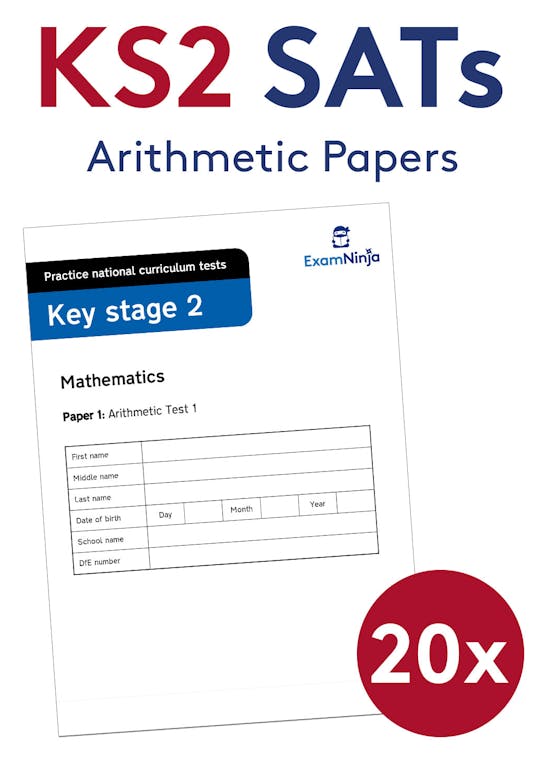What is a prime number?
Prime numbers are positive whole numbers that only have two factors, themselves and 1.
This means that prime numbers can only be made by multiplying themselves by one and are only divisible by themselves or one.
Except the number 2, all prime numbers are odd, but not all odd numbers are prime numbers.
For example:
Is 3 is a prime number? Yes.
3 has only two factors: 3 and 1. 3 can only be made by multiplying 3 × 1 and is only divisible by itself and 1.
Is 7 a prime number? Yes.
7 has only two factors: 7 and 1. 7 can only be made by multiplying 7 × 1 and is only divisible by itself and 1.
Is 9 a prime number? No.
9 has three factors: 9, 3 and 1. 9 can be made by multiplying 9 × 1 and 3 × 3 and is divisible by 9, 3 and 1.
Is 1 a prime number? No.
1 is not a prime number as it has only one factor. 1 is considered a natural number.
Here is a really useful and short video to help children understand the concept of prime numbers:
First 10 prime numbers
The first 10 prime numbers are:
| 2 | 3 | 5 | 7 | 11 | 13 | 17 | 19 | 23 | 29 |
Prime numbers up to 100
There are 25 prime numbers under 100.
Below is a grid of all prime numbers under 100:
| 1 | 2 | 3 | 4 | 5 | 6 | 7 | 8 | 9 | 10 |
| 11 | 12 | 13 | 14 | 15 | 16 | 17 | 18 | 19 | 20 |
| 21 | 22 | 23 | 24 | 25 | 26 | 27 | 28 | 29 | 30 |
| 31 | 32 | 33 | 34 | 35 | 36 | 37 | 38 | 39 | 40 |
| 41 | 42 | 43 | 44 | 45 | 46 | 47 | 48 | 49 | 50 |
| 51 | 52 | 53 | 54 | 55 | 56 | 57 | 58 | 59 | 60 |
| 61 | 62 | 63 | 64 | 65 | 66 | 67 | 68 | 69 | 70 |
| 71 | 72 | 73 | 74 | 75 | 76 | 77 | 78 | 79 | 80 |
| 81 | 82 | 83 | 84 | 85 | 86 | 87 | 88 | 89 | 90 |
| 91 | 92 | 93 | 94 | 95 | 96 | 97 | 98 | 99 | 100 |
How can I check if a number is a prime number?
As children should know their times tables (up to 12 × 12) by the end of Year 4, they should also recognise numbers that don’t appear within those times tables. These are all prime numbers.
If children are unsure then the following prime number testing strategy may help:
- Check if the number is odd (all prime numbers except 2 are odd).
- Check if the number is a multiple of 5. If it ends with 5 or 0 it is not a prime number (apart from 5 itself).
- Does the sum of the digits make a multiple of 3? If the sum of the digits is a multiple of three, it is not a prime number. e.g. 87 = 8 + 7 = 15.
Recommended Products
More commonly asked questions about prime numbers
Is 2 a prime number? Yes.
2 has only two factors: 2 and 1. 2 can only be made by multiplying 2 × 1 and is only divisible by itself and 1. Note: 2 is the first and only even prime number.
Is 5 a prime number? Yes.
5 has only two factors: 5 and 1. 5 can only be made by multiplying 5 × 1 and is only divisible by itself and 1. Note, 5 is the only multiple of 5 that is a prime number.
Key Points
- Prime numbers are whole numbers with only two factors, themselves and 1.
- 1 is not a prime number as it only has one factor.
- 2 is a prime number, it is the only even prime number.
- 5 is the only multiple of 5 that is a prime number.
- The first 10 prime numbers are: 2, 3, 5, 7, 11, 13, 17, 19, 23 and 29.
- The prime numbers to 20 are: 2, 3, 5, 7, 11, 13, 17 and 19.





